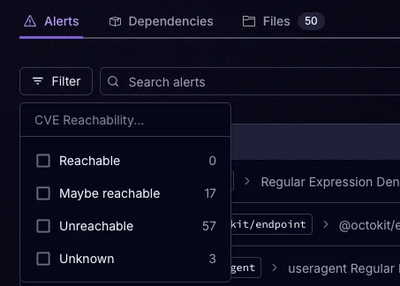
Product
Introducing Rust Support in Socket
Socket now supports Rust and Cargo, offering package search for all users and experimental SBOM generation for enterprise projects.
Get a public suffix for a domain name using the Public Suffix List. Forked from and using the same API as the publicsuffix package.
This module allows you to get the public suffix, as well as the registrable domain, of a domain name using the Public Suffix List from http://publicsuffix.org
A public suffix is a domain suffix under which you can register domain names, or under which the suffix owner does not control the subdomains. Some examples of public suffixes in the former example are ".com", ".co.uk" and "pvt.k12.wy.us"; examples of the latter case are "github.io" and "blogspot.com". The public suffix is sometimes referred to as the effective or extended TLD (eTLD). Accurately knowing the public suffix of a domain is useful when handling web browser cookies, highlighting the most important part of a domain name in a user interface or sorting URLs by web site. It is also used in a wide range of research and applications that leverages Domain Name System (DNS) data.
This module builds the public suffix list as a Trie structure, making it more efficient than other string-based modules available for the same purpose. It can be used effectively in large-scale distributed environments, such as PySpark.
This Python module includes with a copy of the Public Suffix List (PSL) so that it is usable out of the box. Newer versions try to provide reasonably fresh copies of this list. It also includes a convenience method to fetch the latest list. The PSL does change regularly.
The code is a fork of the publicsuffix package and includes the same base API. In addition, it contains a few variants useful for certain use cases, such as the option to ignore wildcards or return only the extended TLD (eTLD). You just need to import publicsuffix2 instead.
The public suffix list is now provided in UTF-8 format. To correctly process IDNA-encoded domains, either the query or the list must be converted. By default, the module converts the PSL. If your use case includes UTF-8 domains, e.g., '食狮.com.cn', you'll need to set the IDNA-encoding flag to False on instantiation (see examples below). Failure to use the correct encoding for your use case can lead to incorrect results for domains that utilize unicode characters.
The code is MIT-licensed and the publicsuffix data list is MPL-2.0-licensed.
Install with::
pip install publicsuffix2
The module provides functions to obtain the base domain, or sld, of an fqdn, as well as one to get just the public suffix. In addition, the functions a number of boolean parameters that control how wildcards are handled. In addition to the functions, the module exposes a class that parses the PSL, and allows for more control.
The module provides two equivalent functions to query a domain name, and return the base domain, or second-level-doamin; get_public_suffix() and get_sld()::
>>> from publicsuffix2 import get_public_suffix
>>> get_public_suffix('www.example.com')
'example.com'
>>> get_sld('www.example.com')
'example.com'
>>> get_public_suffix('www.example.co.uk')
'example.co.uk'
>>> get_public_suffix('www.super.example.co.uk')
'example.co.uk'
>>> get_sld("co.uk") # returns eTLD as is
'co.uk'
This function loads and caches the public suffix list. To obtain the latest version of the PSL, use the fetch() function to first download the latest version. Alternatively, you can pass a custom list.
For more control, there is also a class that parses a Public Suffix List and allows the same queries on individual domain names::
>>> from publicsuffix2 import PublicSuffixList
>>> psl = PublicSuffixList()
>>> psl.get_public_suffix('www.example.com')
'example.com'
>>> psl.get_public_suffix('www.example.co.uk')
'example.co.uk'
>>> psl.get_public_suffix('www.super.example.co.uk')
'example.co.uk'
>>> psl.get_sld('www.super.example.co.uk')
'example.co.uk'
Note that the host part of an URL can contain strings that are
not plain DNS domain names (IP addresses, Punycode-encoded names, name in
combination with a port number or a username, etc.). It is up to the
caller to ensure only domain names are passed to the get_public_suffix()
method.
The get_public_suffix() function and the PublicSuffixList class initializer accept an optional argument pointing to a public suffix file. This can either be a file path, an iterable of public suffix lines, or a file-like object pointing to an opened list::
>>> from publicsuffix2 import get_public_suffix
>>> psl_file = 'path to some psl data file'
>>> get_public_suffix('www.example.com', psl_file)
'example.com'
Note that when using get_public_suffix() a global cache keeps the latest provided suffix list data. This will use the cached latest loaded above::
>>> get_public_suffix('www.example.co.uk')
'example.co.uk'
IDNA-encoding. The public suffix list is now in UTF-8 format. For those use cases that include IDNA-encoded domains, the list must be converted. Publicsuffix2 includes idna encoding as a parameter of the PublicSuffixList initialization and is true by default. For UTF-8 use cases, set the idna parameter to False::
>>> from publicsuffix2 import PublicSuffixList
>>> psl = PublicSuffixList(idna=True) # on by default
>>> psl.get_public_suffix('www.google.com')
'google.com'
>>> psl = PublicSuffixList(idna=False) # use UTF-8 encodings
>>> psl.get_public_suffix('食狮.com.cn')
'食狮.com.cn'
Ignore wildcards. In some use cases, particularly those related to large-scale domain processing, the user might want to ignore wildcards to create more aggregation. This is possible by setting the parameter wildcard=False.::
>>> psl.get_public_suffix('telinet.com.pg', wildcard=False)
'com.pg'
>>> psl.get_public_suffix('telinet.com.pg', wildcard=True)
'telinet.com.pg'
Require valid eTLDs (strict). In the publicsuffix2 module, a domain with an invalid TLD will still return return a base domain, e.g,::
>>> psl.get_public_suffix('www.mine.local')
'mine.local'
This is useful for many use cases, while in others, we want to ensure that the domain includes a valid eTLD. In this case, the boolean parameter strict provides a solution. If this flag is set, an invalid TLD will return None.::
>>> psl.get_public_suffix('www.mine.local', strict=True) is None
True
Return eTLD only. The standard use case for publicsuffix2 is to return the registrable, or base, domain according to the public suffix list. In some cases, however, we only wish to find the eTLD itself. This is available via the get_tld() method.::
>>> psl.get_tld('www.google.com')
'com'
>>> psl.get_tld('www.google.co.uk')
'co.uk'
All of the methods and functions include the wildcard and strict parameters.
For convenience, the public method get_sld() is available. This is identical to the method get_public_suffix() and is intended to clarify the output for some users.
To update the bundled suffix list use the provided setup.py command::
python setup.py update_psl
The update list will be saved in src/publicsuffix2/public_suffix_list.dat
and you can build a new wheel with this bundled data.
Alternatively, there is a fetch() function that will fetch the latest version of a Public Suffix data file from https://publicsuffix.org/list/public_suffix_list.dat You can use it this way::
>>> from publicsuffix2 import get_public_suffix
>>> from publicsuffix2 import fetch
>>> psl_file = fetch()
>>> get_public_suffix('www.example.com', psl_file)
'example.com'
Note that the once loaded, the data file is cached and therefore fetched only once.
The extracted public suffix list, that is the tlds and their modifiers, is put into an instance variable, tlds, which can be accessed as an attribute, tlds.::
>>> psl = PublicSuffixList()
>>> psl.tlds[:5]
['ac',
'com.ac',
'edu.ac',
'gov.ac',
'net.ac']
Using the module in large-scale processing If using this library in large-scale pyspark processing, you should instantiate the class as a global variable, not within a user function. The class methods can then be used within user functions for distributed processing.
Get a local copy of the development repository. The development takes
place in the develop branch. Stable releases are tagged in the master
branch::
git clone https://github.com/nexB/python-publicsuffix2.git
This code is forked from Tomaž Šolc's fork of David Wilson's code.
Tomaž Šolc's code originally at:
https://www.tablix.org/~avian/git/publicsuffix.git
Copyright (c) 2014 Tomaž Šolc tomaz.solc@tablix.org
David Wilson's code was originally at:
http://code.google.com/p/python-public-suffix-list/
Copyright (c) 2009 David Wilson
The code is MIT-licensed. The vendored public suffix list data from Mozilla is under the MPL-2.0.
Copyright (c) 2015 nexB Inc. and others.
Copyright (c) 2014 Tomaž Šolc tomaz.solc@tablix.org
Copyright (c) 2009 David Wilson
Permission is hereby granted, free of charge, to any person obtaining a copy of this software and associated documentation files (the "Software"), to deal in the Software without restriction, including without limitation the rights to use, copy, modify, merge, publish, distribute, sublicense, and/or sell copies of the Software, and to permit persons to whom the Software is furnished to do so, subject to the following conditions:
The above copyright notice and this permission notice shall be included in all copies or substantial portions of the Software.
THE SOFTWARE IS PROVIDED "AS IS", WITHOUT WARRANTY OF ANY KIND, EXPRESS OR IMPLIED, INCLUDING BUT NOT LIMITED TO THE WARRANTIES OF MERCHANTABILITY, FITNESS FOR A PARTICULAR PURPOSE AND NONINFRINGEMENT. IN NO EVENT SHALL THE AUTHORS OR COPYRIGHT HOLDERS BE LIABLE FOR ANY CLAIM, DAMAGES OR OTHER LIABILITY, WHETHER IN AN ACTION OF CONTRACT, TORT OR OTHERWISE, ARISING FROM, OUT OF OR IN CONNECTION WITH THE SOFTWARE OR THE USE OR OTHER DEALINGS IN THE SOFTWARE.
2019-12-19 publicsuffix2 2.20191219
* Add new strict mode to get_tld() by @hiratara .
* Update TLD list
* Add tests from Mozilla test suite
2019-08-12 publicsuffix2 2.20190812
* Fix regression in available tlds.
* Format and streamline code.
2019-08-11 publicsuffix2 2.20190811
* Update publicsuffix.file to the latest version from Mozilla.
2019-08-08 publicsuffix2 2.20190808
* Add additional functionality and handles change to PSL format
* Add attribute to retrieve the PSL as a list
2019-02-05 publicsuffix2 2.201902051213
* Update publicsuffix.file to the latest version from Mozilla.
* Restore a fetch() function by popular demand
2018-12-13 publicsuffix2 2.20181213
* Update publicsuffix.file to the latest version from Mozilla.
2018-10-01 publicsuffix2 2.20180921.2
* Update publicsuffix.file to the latest version from Mozilla.
* Breaking API change: publicsuffix module renamed to publicsuffix2
2016-08-18 publicsuffix2 2.20160818
* Update publicsuffix.file to the latest version from Mozilla.
2016-06-21 publicsuffix2 2.20160621
* Update publicsuffix.file to the latest version from Mozilla.
* Adopt new version scheme: major.<publisiffix list date>
2015-10-12 publicsuffix2 2.1.0
* Merged latest updates from publicsuffix
* Added new convenience top level get_public_suffix_function caching
a loaded list if needed.
* Updated publicsuffix.file to the latest version from Mozilla.
* Added an update_psl setup command to fetch and vendor the latest list
Use as: python setup.py update_psl
2015-06-04 publicsuffix2 2.0.0
* Forked publicsuffix, but kept the same API
* Updated publicsuffix.file to the latest version from Mozilla.
* Changed packaging to have the suffix list be package data
and be wheel friendly.
* Use spaces indentation, not tabs
2014-01-14 publicsuffix 1.0.5
* Correctly handle fully qualified domain names (thanks to Matthäus
Wander).
* Updated publicsuffix.txt to the latest version from Mozilla.
2013-01-02 publicsuffix 1.0.4
* Added missing change log.
2013-01-02 publicsuffix 1.0.3
* Updated publicsuffix.txt to the latest version from Mozilla.
* Added trove classifiers.
* Minor update of the README.
2011-10-10 publicsuffix 1.0.2
* Compatibility with Python 3.x (thanks to Joern
Koerner) and Python 2.5
2011-09-22 publicsuffix 1.0.1
* Fixed installation issue under virtualenv (thanks to
Mark McClain)
2011-07-29 publicsuffix 1.0.0
* First release
FAQs
Get a public suffix for a domain name using the Public Suffix List. Forked from and using the same API as the publicsuffix package.
We found that publicsuffix2 demonstrated a healthy version release cadence and project activity because the last version was released less than a year ago. It has 3 open source maintainers collaborating on the project.
Did you know?

Socket for GitHub automatically highlights issues in each pull request and monitors the health of all your open source dependencies. Discover the contents of your packages and block harmful activity before you install or update your dependencies.

Product
Socket now supports Rust and Cargo, offering package search for all users and experimental SBOM generation for enterprise projects.

Product
Socket’s precomputed reachability slashes false positives by flagging up to 80% of vulnerabilities as irrelevant, with no setup and instant results.

Product
Socket is launching experimental protection for Chrome extensions, scanning for malware and risky permissions to prevent silent supply chain attacks.